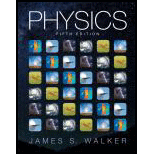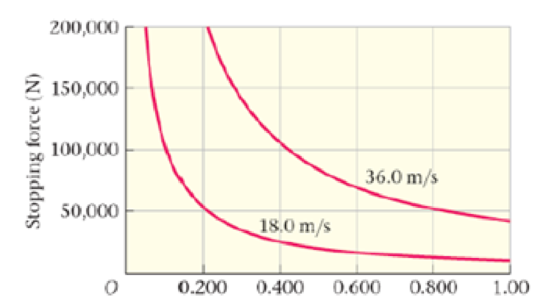
Concept explainers
BIO Increasing Safety in a Collision
Safety experts say trial an automobile accident is really a succession of three separate collisions. (1) the automobile collides with an obstacle and comes to rest; (2) people within the car continue to move forward until they collide with the interior of the car, or are brought to rest by a restraint system like a seatbelt or an air bag and (3) organs within the occupants bodies continue to move forward until they collide with the body wail and are brought to rest. Not much can be done about the third collision, but the effects of the first two can be mitigated by increasing the distance over which the car and its occupants are brought to rest
For example, the severity of the first collision is reduced by building collapsible “crumple zones” into the body of a car, and by placing compressible collision barriers near dangerous obstacles like bridge supports. The second collision is addressed primarily through the use of seatbelts and air bags. These devices reduce the force that acts on an occupant to survivable levels by increasing the distance over which he or she comes to rest. This is illustrated in Figure 5-47, where we see the force exerted on a 65.0-kg driver who slows from an initial speed of 18.0 m/s (lower curve) or 36.0 m/s (upper curve) to rest in a distance ranging from 5.00 cm to 1.00 m.

87. •• The combination of "crumple zones" and air bags/seatbelts might increase the distance over which a person stops in a collision to as great as 1.00 m. What is the magnitude of the force exerted on a 65.0-kg driver who decelerates from 18.0 m/s to 0.00 m/s over a distance of 1.00 m?
- A. 162 N
- B. 565 N
- C. 1.05 × 104N
- D. 2.11 × 104N
Want to see the full answer?
Check out a sample textbook solution
Chapter 5 Solutions
EBK PHYSICS
Additional Science Textbook Solutions
Chemistry (7th Edition)
Applications and Investigations in Earth Science (9th Edition)
Human Anatomy & Physiology (2nd Edition)
Organic Chemistry (8th Edition)
Physics for Scientists and Engineers: A Strategic Approach, Vol. 1 (Chs 1-21) (4th Edition)
Microbiology: An Introduction
- 2. A thin Nichrome wire is used in an experiment to test Ohm's law using a power supply ranging from 0 to 12 V in steps of 2 V. Why isn't the graph of I vs V linear? 1. Nichrome wire does obey Ohm's law. Explain how that can that be true given the results abovearrow_forward1. The average KE and temperature in Kelvin of the molecules of a gas are related by the equation KE = 3/2 KT where k is the Boltzmann constant 1.38 x 10 m² kg s². The diagram shows the energy levels for a Hydrogen atom. Energy/eV 0.00 -1.51 3.39 13.58 Use this information to show that Hydrogen at room temperature will not emit light. 2. When hydrogen burns in oxygen 241.8 kJ of energy are released per mole. Show that this reaction can produce light.arrow_forward3. By using the fact that around any closed loop the sum of the EMFS = the sum of the PDs. Write equations for the two loops shown in the cct below. 40 ΔΩ I₂ 4V (loop1 20 (loop2) 2v I+12 Use these equations to show that the current flowing through the 20 resistor is 0.75Aarrow_forward
- 5. A potential divider circuit is made by stretching a 1 m long wire with a resistance of 0.1 per cm from A to B as shown. 8V A 100cm B sliding contact 5Ω A varying PD is achieved across the 5 Q resistor by moving the slider along the resistance wire. Calculate the distance from A when the PD across the 5 Q resistor is 6 V.arrow_forward4. A voltmeter with resistance 10 kQ is used to measure the pd across the 1 kQ resistor in the circuit below. 6V 5ΚΩ 1ΚΩ V Calculate the percentage difference between the value with and without the voltmeter.arrow_forward1. A 9V battery with internal resistance 5 2 is connected to a 100 2 resistor. Calculate: a. the Power dissipated in the 100 2 resistor b. The heat generated per second inside the battery. C. The rate of converting chemical to electrical energy by the battery. 2. A 230 V kettle is rated at 1800 W. Calculate the resistance of the heating element.arrow_forward
- 2. If each of the resistors in the circuit below has resistance R show that the total resistance between A and B is 5R/11 A Barrow_forward1. At 0°C a steel cable is 1km long and 1cm diameter when it is heated it expands and its resistivity increases. Calculate the change in resistance of the cable as it is heated from 0-20°C The temperature coefficient of resistance a, gives the fractional increase in resistance per °C. So increase in resistance AR = Ra.AT Where R, is the resistance at 0°C For steel a, 0.003 °C The coefficient of linear expansion a- gives the fractional increase in length per °C temperature rise. So increase in Length AL La-AT Where L, is the length at 0°C For steel a₁ = 12 x 10 °C-1 The resistivity of steel at 0°C = 1.2 x 10 Qmarrow_forward1. F E 6V 10 1.1. B a 6V b C C Apply Kirchoff's 1st law to point C for the circuit above Apply Kirchoff's 2nd Law to loops: a. ABCFA b. ABDEA C. FCDEF d. Find values for currents a,b and c Darrow_forward
- 2. The results of the Rutherford experiment can be categorized in 3 statements. Fill in the missing words Most 11. Some III. A few State which result gives evidence that the nucleus is a. heavier than an alpha particle b. very small compared to the size of the atom c. positively charged 3. Using values in the diagram derive an expression for r .0 e marrow_forward3. A 100 W light bulb is connected to 230 V mains supply by a cable with resistance 0.12. Determine the heat loss per second by the cable.arrow_forward1. The image shows electrons flowing in a conductor with cross sectional area 1mm². A electron flow • Add an arrow showing the direction of current. B • Which end has the highest potential? • Calculate the current when 1019 electrons flow through the wire in 10 s. If there are 1026 electrons per unit volume what is the drift velocity of the electrons?arrow_forward
 Physics for Scientists and Engineers: Foundations...PhysicsISBN:9781133939146Author:Katz, Debora M.Publisher:Cengage Learning
Physics for Scientists and Engineers: Foundations...PhysicsISBN:9781133939146Author:Katz, Debora M.Publisher:Cengage Learning College PhysicsPhysicsISBN:9781938168000Author:Paul Peter Urone, Roger HinrichsPublisher:OpenStax College
College PhysicsPhysicsISBN:9781938168000Author:Paul Peter Urone, Roger HinrichsPublisher:OpenStax College Physics for Scientists and Engineers, Technology ...PhysicsISBN:9781305116399Author:Raymond A. Serway, John W. JewettPublisher:Cengage Learning
Physics for Scientists and Engineers, Technology ...PhysicsISBN:9781305116399Author:Raymond A. Serway, John W. JewettPublisher:Cengage Learning Principles of Physics: A Calculus-Based TextPhysicsISBN:9781133104261Author:Raymond A. Serway, John W. JewettPublisher:Cengage Learning
Principles of Physics: A Calculus-Based TextPhysicsISBN:9781133104261Author:Raymond A. Serway, John W. JewettPublisher:Cengage Learning College PhysicsPhysicsISBN:9781285737027Author:Raymond A. Serway, Chris VuillePublisher:Cengage Learning
College PhysicsPhysicsISBN:9781285737027Author:Raymond A. Serway, Chris VuillePublisher:Cengage Learning Physics for Scientists and Engineers with Modern ...PhysicsISBN:9781337553292Author:Raymond A. Serway, John W. JewettPublisher:Cengage Learning
Physics for Scientists and Engineers with Modern ...PhysicsISBN:9781337553292Author:Raymond A. Serway, John W. JewettPublisher:Cengage Learning





